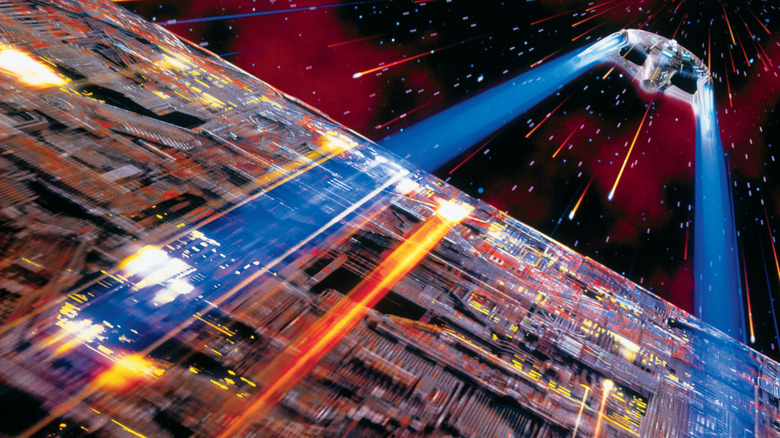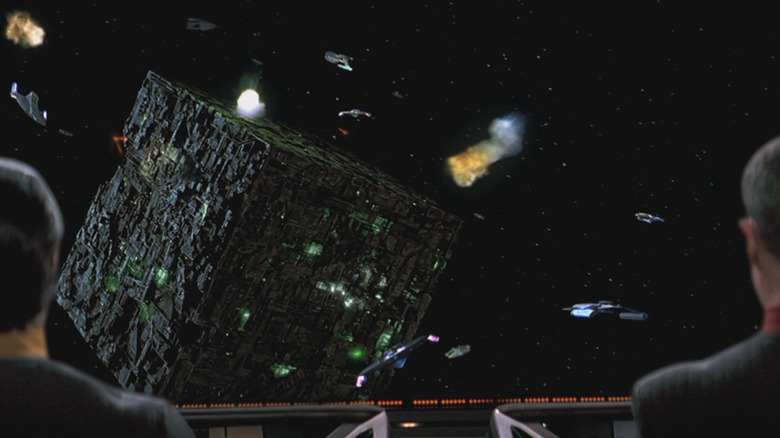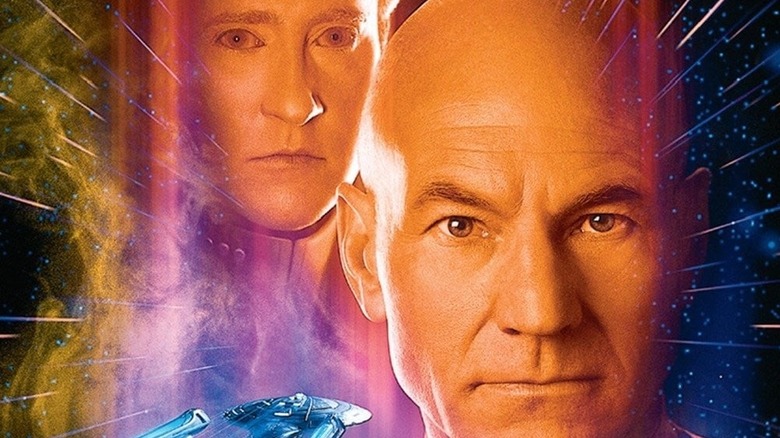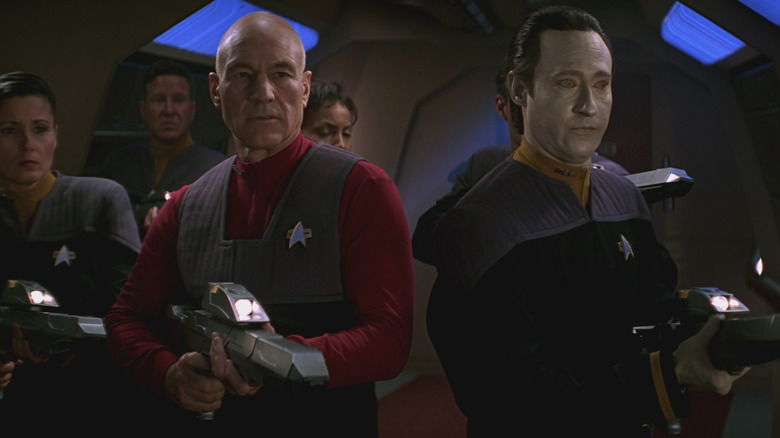The Writers Had Much Grander Plans For Star Trek: First Contact
"Star Trek: First Contact" — released in November of 1996, and the second "Star Trek" film to feature the "Next Generation" cast — was the best-received of the NextGen-based "Star Trek" feature films. Boasting some pretty great special effects, a good deal of action, and a plot featuring fan-favorite villains the Borg, "First Contact" was a big hit (at the time, it became the second-highest grossing Trek film after "Star Trek IV: The Voyage Home"). Many responded to the film's high-octane action, which was a departure from the diplomacy and morality plays of the "Next Generation" TV series. It's like audiences just wanted something a little more exciting after the relatively turgid "Star Trek: Generations" from two years before.
As with many high-stakes studio features, "Star Trek: First Contact" went through its share of tinkering and re-working before finally ending on the story they had. Some of the original ideas for "First Contact" seems like they needed minor corrections, while others would have made the film far, far larger and way more expansive. Syfy Wire interviewed executive producer Ron D. Moore on the film's 25th anniversary in November of last year, and he revealed what some of those original ideas were, and why they eventually had to be cut from the final film.
Wolf-359
The first major plot point in "Star Trek: First Contact" is that the Borg — a race of soulless cyborgs who kidnap people and assimilate them into their machine collective — are about to invade Earth. While Picard and the Enterprise are eager to fight off the threat, they are expressly disinvited from the battle, as Picard's past with the Borg (he was once assimilated himself) may put others in danger. Picard immediately defies those orders and joins the fray anyway. In a very impressive sequence that still looks great to this day, there is a grand battle with the cube-shaped Borg ship.
Moore reveals that the battle was supposed to take up a much larger portion of the film, and was intended to be far more elaborate:
"We had, first, the big battle, then the Enterprise coming in, and then there were all these descriptions of this starship comes over and does this, and it takes that kind of hit and then this ship spins. And so there was a lot of just bells and whistles to it."
But, Moore laments, what the production crew was envisioning became mired down by budgetary concerns, and a few unfortunate habits leftover from when "Next Generation" was still budgeting for TV:
"Oh yeah. We kept having to cut down. I couldn't tell you what it was [exactly], but everything was broken down into discreet shots and sequences ... Over the course of production, you're just cutting and cutting and consolidating and begging and trying to scrape together money. Arguing why this one shot is the most important, or more important than this other one over here. And you do that just with everything, especially at that stage with the state of technology and CG at the time, it wasn't really a cheap conversation."
TV thinking
Moore had assumed that working on a feature film would have granted the filmmakers a lot more budgetary leeway when it came to envisioning certain sequences. This was, after all, a feature film meant to look bigger and slicker than the comparatively low-budget TV show on which it was based. It turns out, a lot of the penny-pinching inherent to a TV program was in full force on a feature:
"You have this tedious exercise in the production meeting where you are literally counting the shots: How many shots can work, how many can you shoot [onscreen], and how many times do you have to get, you know, 'Data's going to fire from off-camera' to save the production some cash. We had those on the show, too, a lot. And here, it was so excruciating because — you kind of felt that, once [we] got into the features, they were going to give us a bucket of money and we were not going to have those kind of conversations anymore. And we did end up have those same conversations, it was just, you added a zero to all the dollar figures because everything costs more at the feature level."
Mind you, this was in 1996, when ultra-expensive $175 million blockbusters weren't the norm. Even a large-scale genre film with a recognizable brand and a built-in audience wasn't going to get the kind of financial attention that an Avengers film might. This was all based on predictive bookkeeping and dry "Moneyball"-like calculations:
"Paramount's position at the time was: A Star Trek movie will make this amount of money. Therefore, we will give you this amount of money, so that we have this amount of profit. And it was very much a formula. I'm trying to even grasp it. I think it was like $75 million or something, including marketing. That's the budget. Period. End of story. Because these films don't earn more than this [amount], and the studio doesn't want to earn less that. So the studio is like: 'We shoved it through our system, there's your budget, be on your way.' And that was it."
Action, action, action
Until the release of the rebooted "Star Trek" film in 2009, "Star Trek: First Contact" was most certainly the most action-packed entry in the series. There was a fast-moving starship battle, a lot of phasers, and an action movie ending wherein Captain Picard melts the skin off of a villain with a tube of flesh-eating gas, all while he wore a tank top and showed off his biceps. A conceit of the movie is that the Borg have infiltrated the Enterprise, and are slowly assimilating it, and there are action sequences throughout the ship as Starfleet crew members try to abate the assimilation. The original vision was also to expand those action sequences to even more places on the ship, involve more witty banter between them, and involve even more characters:
"There were just expanded sequences. There was just more action in general, more fighting the Borg in the corridors, and going into different places on the ship. And I think there was more humor. A lot of the jokes got cut down. I think we had more fun with Troi (Marina Sirtis) and Cochran's relationship on Earth, where he gets her drunk. We had more to that sequence scripted and that was fun to write, too. [Executive Producer] Rick [Berman] might have made us cut it because he was always a little too ... he was always kind of worried that maybe the humor would be too corny or something."
There was even a conceived sequence — never shot — set in a turbolift shaft. The idea was that the shaft was so large, it had its own weather system, and Picard was going to manipulate the weather to best a team of Borg pursuers, including harnessing static electricity from interior clouds:
"[The turbolift sequence] was inspired by something I had read about the NASA vertical assembly building, which is this massive block where they assembled the Saturn V rocket. The interior space of that complex was so big, that it literally had its own weather system at the top. Like it would have its own moisture and would kind of rain in there. And I remember reading that and it stuck with me for years. I was always fascinated by that concept. And I always wanted to do something like that inside the Enterprise. It would have been great to do it for a movie, you'd think we would be able to, but..."
But it was never to be. Budgets were too small, time was too much of a factor, and 1990s sci-fi blockbusters weren't being assembled on the scale they would be 15 years later. The version of "First Contact" audiences never got to see is yet another story to put in the history books next to all the other films that didn't get to do things they way they wanted to.



